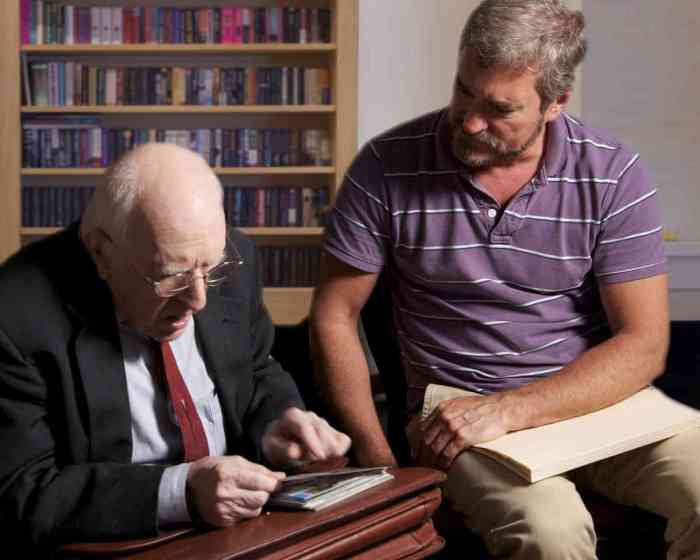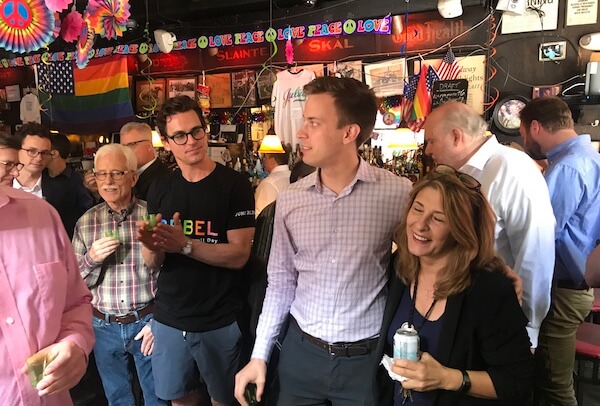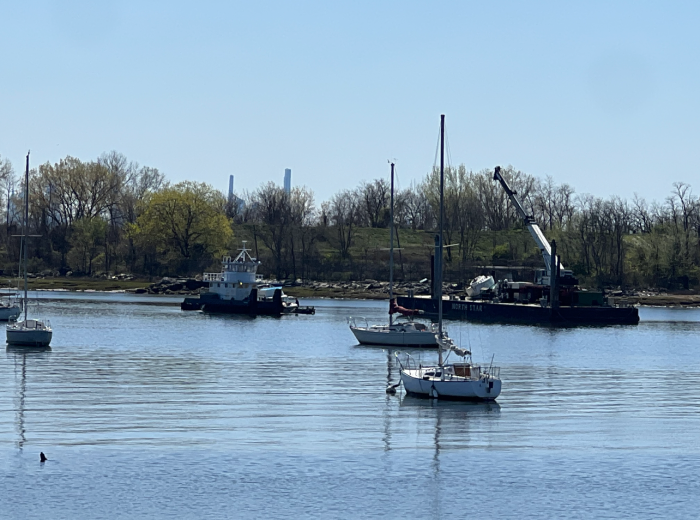Dr. George Weinberg’s 1972 book first brought the term “homophobia” to a wide audience. | MACMILLAN BOOKS
BY DR. GEORGE WEINBERG | May of 1965. A small group of daring revolutionaries rented the auditorium of the Barbizon Hotel in Midtown Manhattan for a meeting of the East Coast Homophile Organization — a name that does not resonate today – but the group was one that changed the course of LGBTQ history four years before the Stonewall Rebellion.
Of the roughly 25 homosexual men and women in the United States who were out publicly to everyone and not just to certain other gay people, about half of them were at that meeting. For the other attendees, secrecy was their way of life. In most states — including New York — you could do up to 10 years for a consenting homosexual act with another adult and you could be fired if you were known to be homosexual or even suspected of it. If you worked for the government, they fired you at once and you lost your pension. This led to a lot of blackmail.
A practicing psychotherapist and heterosexual, I had met members of the budding “homophiles” group only recently and had agreed to talk at that Saturday meeting at the Barbizon. I had gotten my doctorate in clinical psychology from Columbia where the handful of homosexual students lived in terrified secrecy. Colleges were as anti-gay as most of the rest of society and even my close friends who were gay were hesitant to tell me.
An early psychotherapist ally recalls discovering why his colleagues despised gay people
The conference was organized mostly by Dr. Frank Kameny, an outstanding Ph.D. astronomer. Once a would-be astronaut, Frank was barred from continuing to work in his field after being caught in a homosexual act. It was as if the government were saying, “It’s not safe to let perverts look through the big lens at the sky.” Frank was to devote the rest of his pioneering life — 50 or so more years — to changing laws and attitudes toward gay people. He came up with the slogan “Gay is Good,” a radical departure from the view of the vast majority of people at the time — including many homosexually-oriented people themselves — who viewed homosexuality as criminal, evil, and sick.
The group called themselves “homophiles” to mean people sympathetic to the cause, whether gay or not. In my presentation to them, I declared that being gay ought to be about as consequential in actuality as being left-handed. I reminded them that the word for left-handed in Latin was “sinister” and that into the 20th century left-handed children were often forced to write with their right hands, an approach that sounds ridiculous — even barbaric — to us today.
My simple analysis of sexual orientation as a characteristic as neutral as handedness or eye color was embraced by them almost immediately.
My own experiences with gay people had led me to this formulation. I saw them suffering needlessly. Nearly all were secretive about their private lives, many even with me. That included dear friends. Most hated themselves. Suicides were not uncommon. Their problem was not their orientation, but their self-hate. Their problem wasn’t with being gay, it was with an oppressive society. We needed a word for that, but it would not come to me for a few years.
None of my fellow psychotherapists were there and those who learned of my analysis were very unhappy with me. They felt sure that being gay was a treatable illness. It was a profitable hypothesis, binding gay patients for their lifetimes to “treatment” that was never going to work. Given societal condemnation, the desire of gay patients to “change” was intense. While some could be coached into altering their behavior and functioning heterosexually in order to fit into the culture, their desires never changed.
Back then, I naively imagined that psychologists and psychiatrists simply didn’t understand the plight of gay people. They had never seen a successful and fulfilling gay relationship or one that lasted and so were convinced that they all ended badly. They took pains to warn children against being alone with gay people and by doing so further convinced themselves that gays were a rotted branch of humanity. Some had gay friends but not out gay friends. They said terrible things about gay people and found only agreement.
I thought that I could teach them better. But how? I decided to try a method used by no less a person than Kinsey himself.
A friend of mine who was gay and very “straight-appearing” told me that he had worked for Dr. Alfred Kinsey as a photographer. Kinsey liked him very much. One day Kinsey had asked him for a favor: “Visit me alone and stay at my home in Bloomington, Indiana, for a few days. I’ve also invited a man who is a top-notch lawyer; he is considering helping us with our next book, ‘Sex and the Law.’ I very much want him on board, but I’m not sure how he feels about gay people. After you have spent several days with him, he will like you. Then we invite your lover to join us. When he finds out you are gay, he will reconsider his viewpoint. He will revise his opinion of gays. Or at least let’s hope so.”
The plan worked perfectly for Kinsey.
I decided to duplicate it, introducing the same man, C.A. Tripp (who in 1975 would write the groundbreaking “The Homosexual Matrix”), to a few therapist friends, including some outstanding figures in psychology. They all met several times over a period of months. They liked Tripp and encouraged him to pursue his dream of becoming a psychologist. They seemed a little disappointed that he wasn’t married but the topic went no further. Finally, it was time and we invited Tripp’s lover to join us.
Once he brought his lover to meet them, however, they all turned against him — finding fault with him and regarding him as sick and unpleasant. They had been suddenly repulsed by him and felt tricked by me. They didn’t want to see Tripp again or even discuss him. It was as if he had become rancid.
For them, homosexual people were either to be treated or viewed with dread and disgust or as dangerous.
Reconsidering the reactions of these professionals, I thought back over signs I’d already had that they would react that way. They weren’t troubled by the exclusion of gays from jobs or their instant firing or even by their imprisonment or the fact that the police were slow to pursue people who murdered gays. They talked at length about the imagined harm that gay people could do to a society. Behind such hatred and prejudice, I realized, was stark fear.
It struck me that gay people should know this. “They don’t just hate you. They are afraid of you.” Since the fear was irrational, gay people couldn’t make peace with those who held it — at least not by good behavior alone. Statistics didn’t help. For instance, data shows that a disproportionate number of molestations of children are done by heterosexual family members, adults who have trusted access to them — not by gay adults. But fear doesn’t succumb to data.
Why do we fear groups that aren’t dangerous? The answer is that fear is perpetuated and enlarged by acts of fear. Kill those in a group, ostracize them, deprive them, talk against them, abuse them in any way, and you will magnify and renew your fear of them. You will have given them the right to hate you and you will fear them and not just hate them. Mistreat people and you will fear them. The oppressor doesn’t want to see himself as hateful so he condemns — often attributing supernatural powers to the victim. This once held for left-handed people and those born out of wedlock; it still holds among many regarding women and people of color.
The word “homophobia” came to me as a way of summing up this irrational fear — and dread. Frank Kameny liked it and so did my other gay activist friends. Early leaders Jack Nichols and Lige Clarke, themselves a couple, used it in their articles for the underground press including the newspaper Gay, and so did I. Activists Barbara Gittings of Philadelphia and Lilli Vincenz of Washington used it regularly in speeches. It was more successful than I ever imagined it would be. Gay people could do more than say, “I am not the one who is sick. Maybe you are and here’s the illness that you have.” They had a diagnosis for their oppressors and could do more than play defense.
I remember how exciting it was to see the word used by others. In fact, it still is. I used it in speeches and on TV when an occasional host had me on to present the case for accepting gay people and for gay people accepting themselves. I got a young graduate student to do a do a study of homophobia and its correlates. The word caught on. It was just what the movement needed. It caught on because it was right. There are a lot of downsides to getting older, but an upside is that I can quickly juxtapose in my mind the status of gay people then and now. It was all done by bold work of a handful of people armed with the insight that it was not gay people who had the problem but a sick society that did.
The early steps toward equality were small after that meeting in 1965 — a handful of gay demonstrations and uprisings in Philadelphia, New York, Los Angeles, Washington, and San Francisco. Then came the Stonewall Rebellion in Greenwich Village in ’69 and, as Dick Leitch of the Mattachine Society, a pre-Stonewall group, said, “We went from no one being out to everyone being out.”
The unique thing about Stonewall is that it led to immediate and ongoing LGBTQ organizing, first with the radical Gay Liberation Front in New York and London, then with the Gay Activists Alliance and Lesbian Feminist Liberation, and within a few years thousands of groups in cities across the country and around the world. One of the first great and essential victories of the early gay movement was getting the American Psychiatric Association to remove homosexuality from its official index of mental disorders in 1973 — a seismic shift that catalyzed the progress of the movement. It put homophobia on the run.
Despite immense progress, the battle against homophobia is not won — certainly not around the world with more than 70 countries still criminalizing same-sex relations and not even in the United States where we have yet to enact a simple federal law banning discrimination based on sexual orientation and gender identity (though more than half the country is covered by such protections on the state and local level). As homophobia has ebbed, transphobia has increased as the right wing — for political advantage — spreads the fear of transgender people in restrooms. And the new Trump administration seized power by stoking fears of a host of “others” — immigrants in general but people from Muslim nations in particular, who are being subjected to Islamophobic exclusions. Until we can conquer our fears, we will be ruled by them — and millions of blameless people will suffer.
Have no fear.
George Weinberg died in Manhattan on March 20 at the age of 87. At the time of his death, Weinberg was completing work on this essay with the editing assistance of Andy Humm.


































